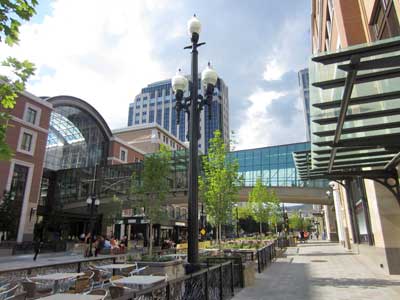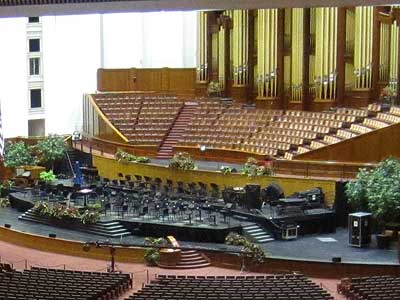SALT LAKE CITY (Day 21)
It was a 5 hour drive down to Salt Lake City where I met up with Shawn, a couchsurfing host who was going to put me up for the night. He took the day showing me around the city.


City hall ... and a great view from inside the library


Heading downtown




We explored the buildings at Temple Square.


The Salt Lake Temple is the sixth temple built by the Church of Jesus Christ of Latter-day Saints (LDS). It is the largest LDS temple in terms of square footage and was dedicated in 1893 (three years before Utah became a state) after taking 40 years to complete.
If their proper name is Latter-day Saints, why are they always called Mormons? Mostly because it's shorter and easier. It comes from the Book of Mormon, a book of scripture that supplements the Bible and contains the writings of ancient prophets who lived on the American continent from approximately 2200 BC to 421 AD. It was first published in 1830 by Joseph Smith, the first prophet of the LDS church.
According to Smith, he was 17 when an angel named Moroni appeared to him and said that a book was buried in a nearby hill (in the state of New York). Engraved on golden plates, it described the former inhabitants of this continent whom God had led here from Jerusalem 600 years before the birth of Christ. The stories in the book end in the ancient land Cumorah, where Moroni (the son of the prophet Mormon and the last of the Nephite prophet-historians) buried them in 421 AD. Smith located the plates, translated them into English from an unknown language that he was capable of reading using seer stones, then returned them to the angel without letting anyone else see them.
But what does the word Mormon mean? There has been much confusion about this, even from Smith himself back in the 1800's.
- Smith wrote that Mormon means 'more good,' from a shortened 'more' and the Egyptian word 'mon' for good.
- From a Freemason point of view (since Smith was one), it could refer to the captain of a vessel, since the Moors (mor) were known as were known navigators or men (mon) of the seven seas.
- Or it could be named after Mormon, an ancient prophet who lived in the Land of Mormon, the sacred ground where the first church was established. There is, however, no agreement as to where this land actually was, other than somewhere in the Americas. It could have been Guatemala, Lake Erie or even Missouri.


An image of a gold plate adorns the front of the church...

... and the angel Moroni graces the top.

Joseph Smith Jr. ( 1805 - 1844) was the fifth of eleven children of Joseph Smith and Lucy Mack.
In the South Visitors’ Center, there was a 1:32 scaled replica of the temple. Since only church members are allowed to enter the temple, this was the closest I was ever going to get.


An overview ... stairs


Celestial room ... Assembly room


Baptistery ... Ordinance instruction room
The baptismal font rests on the backs of 12 oxen, following a tradition in the Old Testament. They represent the 12 tribes of ancient Israel.
Nearby (also located in the Temple Square), the Assembly Hall was constructed in a Gothic Revival style in 1880 from the granite left over from building the temple.




The auditorium holds almost 2,000 people, with 100 choir seats.
Across the street was the LDS Conference Center. Completed in 2000, it was intended to replace the traditional use of the nearby Salt Lake Tabernacle, built in 1868. With 21,000 seats, it is believed to be the largest theater-style auditorium ever built.





There were also great views of the city from the top.
We wandered through some more church area.




The Church Office Building serves as their headquarters.
Nearby was the Brigham Young Historic Park.


Brigham Young (known to his followers as Brother Brigham) was president of the church from 1847 to 1877. The park is representation of the lives and industry of these early pioneers. The Young family estate included this site. The property was large enough to accommodate a carpenter shop, shoe shop, blacksmith shop, a pigeon house, a flour mill, barns, sheds and corrals. There was also a vegetable garden and an orchard with apple, peach, pear and walnut trees, as well as beehives.


Tending the garden


Quarrying the granite and sandstone from nearby canyons for the temples, homes and buildings. ... Waterwheels were used to power the mills. The first mill, built in 1847, was a gristmill used to grind wheat.
Spanning over N. State Street was the Eagle Gate. The gate, built in 1859, marked the entrance to Brigham Young's homestead. During the early settlement of the valley, Young was allotted the land by the mouth of City Creek Canyon. He built a high wall around the property, both for privacy and protection. The original gate was carved from laminated wooden blocks and rested on curved wooden arches, anchored in the cobblestone wall surrounding the estate. Large wooden gates closed the opening at night.


More church buildings....

The Beehive House served as Brigham Young's residence, office and reception area for official visitors. It was designed by his brother-in-law, Truman O. Angell, in 1853. Its name comes from a cupola on top. In 1888, Young's son expanded it with a 3-story wing.


The front of the LDS administration building... and the lobby of the Joseph Smith Memorial Building
In the evening, we drove up to Park City, a charming albeit touristy town about 30 miles away. Founded in 1868 during the height of silver mining in the area, it has since turned into a popular mountain resort.


Main Street




return • continue

